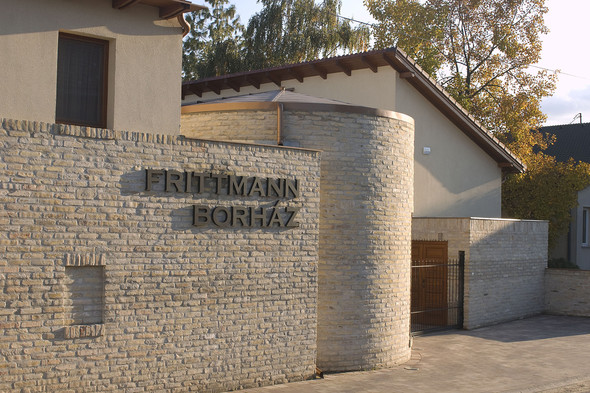The wines of the sandy, flat Alföld (the Great Plain) are generally looked down upon as below-par quality, mass-market wines. While to a certain extent this is still true for many wines in this area, there are some wineries which are beginning to break the mould and produce award-winning wines, which are generally very competitively priced. One such winery is Frittman Borászat, who has just won Winery of the Year 2015, beating Béres Szőlőbirtok (Erdőbénye) and Csányi Pincészet (Villány) into second and third place respectively.
Some of the criteria taken into account include appearance of winery, both interior and exterior, participation in the local community, membership of national or local organisations and associations, and international relationships. Of course, the wines themselves also play a part! Here, the quality and range of products is important, as is their presence on domestic markets and their export capabilities. Participation and success in competitions also gains the winery points.
The presentation of the award took place last week at the winery, which journalists and other guests were invited to attend, along with a buffet lunch and the possibility to sample their range of wines.
The day did not begin too propitiously when the bus taking us from Budapest to the Kunság failed to materialise until an hour after the appointed time due to heavy traffic; the gathered journalists spending this time dodging further buses manoeuvring next to the Danube. Having avoided being run over and departed late, we arrived in the centre of the incongruous-looking small town of Soltvadkert in the nick of time for the award ceremony.
As the bus began to drive through vines, I peered out of the window, curious to see this ‘sandy’ soil of the Great Plain. Sand not generally believed to be too hospitable to viticulture. It was indeed very sandy – one on side of the road, the soil resembled a beach. This is an important aspect relating to wines produced in this area. Not only is sand not usually the best of options for viticulture, it is also not very friendly territory for phylloxera, thus the vines here do not have to be grafted onto American rootstocks resulting in significantly lower costs.
The ceremony took place in the courtyard of the modern winery, which was completed in 2007, the year in which János Frittmann won Winemaker of the Year. Since then, the winery has continued to make wines according to their family philosophy as well as expanding their range of wines. They now produce a range of still wines from local varieties as well international, several lightly sparkling, prosecco-style wines, a sparkling wine from Ezerjó and a range of pálinkas, the traditional Hungarian fruit brandy.
We took the opportunity to taste some of their range (click here for tasting notes), including a 2015 rosé made from the unusual Néró variety. Unfortunately this will not be available as a single varietal wine, but rather used in a blend, so was probably the only chance to try this.
Tasting notes
FriSecco Irsai Olivér-Ezerjó
Slightly sparkling, fresh, youthful wine. Fruity, aromatic, floral, perfumed character from the Irsai Olivér variety. Some notes of lychee and peach. Crisp acidity with a touch of bitterness on the finish. Slightly oily texture balances the relatively high acidity. A nice refreshing sparkler on a summer afternoon.
FriSecco Kékfrankos rosé
Light, refreshing, slightly sparkling wine. Not overtly fruity, although there were some notes of strawberries and raspberries on the palate. Lively acidity with a pleasant finish.
Frittmann Gold, traditional method sparkling wine (Ezerjó)
A pleasant, crisp sparkling wine with plenty of fresh fruit, particularly green fruit such as apple and lime. Clean and refreshing, but lacking the yeasty, brioche notes generally associated with traditional method sparklers.
Ezerjó 2014
A relatively simple, light wine with some notes of citrus and apple. Somewhat neutral with quite pronounced acidity.
Irsai Olivér 2014
Pale lemon-green wine. Fresh, fruity, grapey aroma with floral notes. Crisp, refreshing acidity with flavours of lemon and grape and some floral undertones. A good representation of the variety. A light summer wine, good as an aperitif.
Cserszegi Fűszeres 2014
Dry, light, fresh wine with spicy, aromatic nose. Fruity on the palate, with muscat grape and crisp citrus flavours. Lively acidity makes this a refreshing wine on a hot day.
Néró Rosé 2015 (barrel sample)
A fragrant wine with aromas of rose, rosehip and redcurrant. Perhaps a little lacking in acidity, but an unusual combination of flavours mirroring the nose. Usually only used in blends.
Kadarka 2013
Pale ruby in colour, a light fruity wine packed with red plummy fruit, but perhaps a little stewed. Although the spicy note and smooth tannins make this a very drinkable wine.
Cabernet Franc FPV (Frittmann Pince Válogatás) 2009
Dense, intense wine with plenty of black and red berry fruit and chocolate on the nose. On the palate, smooth tannins, black fruit, prunes and chocolate. Some green pepper notes imply slightly underripe grapes. Lingering fruity finish.






